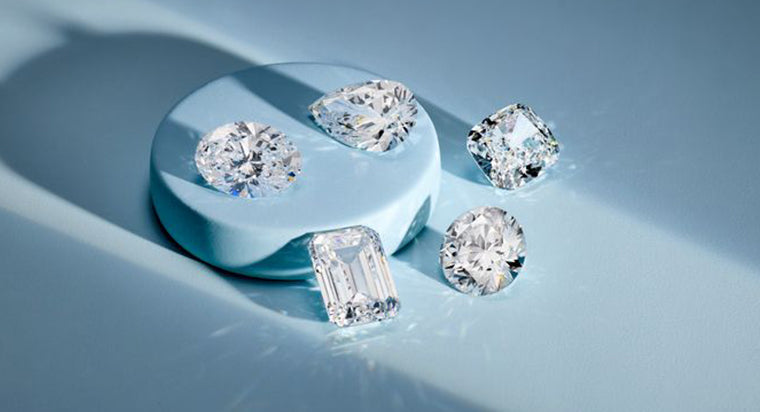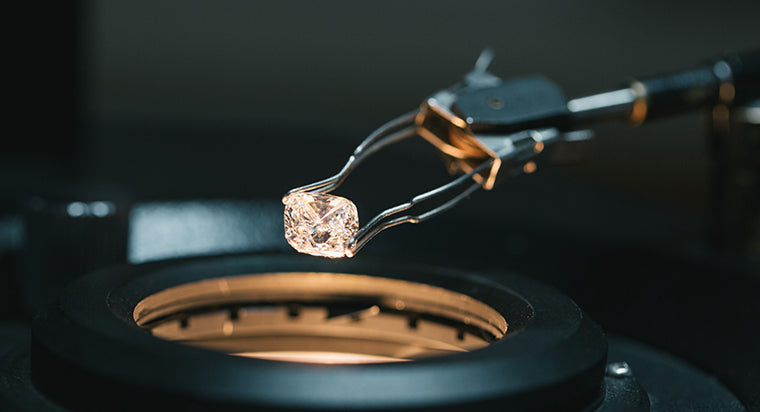What is an IGI Certificate for a Lab Grown Diamond

As the name suggests, IGI lab grown diamonds (also known as man made, cultured and engineered diamonds), are carefully produced in cutting-edge laboratories. The delicate process used encourages the growth of man made diamonds. The environmental conditions are carefully monitored to replicate the surroundings of a mined diamond, and the results are impressive. As with all high-quality items, regulation is beneficial to ensure consumers get a good deal, and that's where IGI certification comes into play.
TABLE OF CONTENTS
IGI Lab Diamond Certification
The International Gemological Institute (IGI) was established back in 1975, and now has headquarters all over the globe. The independent laboratory carefully studies colored stones and jewelry, along with lab grown diamonds, to determine authenticity. Following an assessment, the experts compile an IGI lab grown diamond report to outline the results. Vendors can display the IGI certificate along with the IGI diamond, allowing potential buyers to verify the diamond is the authentic sparkler they believe it to be!
IGI Diamond Criteria
IGI employs a team of expert gemologists to scientifically determine the quality of each diamond. Gems are graded against certain criteria, and this criterion is based upon four elements we refer to as the four C's:
Carat
Diamonds are measured in terms of weight and we refer to this as carat weight. The carat weight plays a big part in determining the value of the diamond. Lab diamonds are formed differently than natural diamonds, however, they are still measured on the same scale for carat weight which is the main determining factor of size. Because shapes and cutting methods are the same, carat is on the same scale for natural and lab diamonds.
Color
Diamond color is measured on a scale from D to Z, where “D” is equal to a color-free diamond and “Z” implies the diamond has a yellow hue. Experts also check for fluorescence. Fluorescence is if the diamond emits light when under a UV lamp. The fluorescence scale runs from “none” to “strong.” While lab diamonds are affected differently by the environment in which they are created, there are still grades and variations in the color. They can be affected by the seed quality and the other elements that can be introduced to the diamond while it is being grown.
Clarity
Gemologists use x10 magnification to get a close up look at the clarity of the diamond. The scale runs from “I” (included) which indicates visible flaws, to “FL” (flawless), which indicates no flaws can be seen - even when the diamond is magnified. Inclusions form much the same way in natural and lab grown diamonds.
Cut
The cut looks at a number of elements, including how well the diamond is polished (smoothness) how symmetrical the diamond is (cutting precision) and proportions (measurements including crown height, table, etc). Grade wise, cutting is rated from “poor” through to “excellent.” Cutting is a factor of how well diamonds are cut from the diamond rough that is formed in the lab. Cut is the most important 4C to consider.

IGI Grading Reports
IGI diamond grading reports include vital information regarding the diamond. Here's a brief summary of the information you can expect to see relating to IGI certified lab grown diamonds:

Description
Briefly describes what type of diamond it is, in terms of material and origin. In this case, all of With Clarity's lab diamonds are IGI certified.
Shape and Cut
The shape of a diamond and its type of faceting style. Is the diamond round, or fancy shaped? About its faceting style, how symmetrical is the diamond (cutting precision) and its proportions (proportions including depth, table, crown height, pavilion depth, girdle, and culet)?
Measurements:
Carat Weight
Carat (ct) refers to the actual weight of a diamond. The carat weight (ct) is a significant factor in the price of a stone. Therefore when carat weight increases, the price responds the same. When it comes to lab grown diamonds, individuals are able to purchase a stone with a higher carat weight for a lower price versus a natural diamond.
Color Grade
Diamond color grade is based on the absence or presence of color. The color is graded on an alphabetical scale starting at D going down to Z. “D” means the diamond is colorless and “Z” means the diamond has a yellow hue. While lab diamonds are affected differently by the environment in which they are created, there are still grades and variations in the color. Man made diamonds can be affected by the seed quality and the other elements introduced while it is being grown.
Clarity Grade
Clarity measures the size, number, location of internal lab diamond characteristics. The visibility of any imperfection(s) is also factored in. An expert gemologist uses x10 magnification to get a close up look at the clarity of the diamond. The scale runs from “I” (included) which indicates visible flaws, to “FL” (flawless), which presents no flaws that can be seen - even at magnification. Inclusions appear much the same way in natural and lab grown diamonds.
Cut Grade
The cut grade looks at several elements, including how well the diamond is polished (smoothness), to how symmetrical the diamond is (cutting precision), and its proportions (measurements including crown height, table, etc). Grade wise, cut is rated from “poor” through to “excellent.” Cutting is a determinant of how well diamonds are cut from the diamond rough formed in the lab. The most important question here is, how well is the diamond cut to produce that dazzling sparkle?
Proportions:
Table
The measurement of the table, or largest facet of a diamond. In IGI certification, the size is shown as a percentage by calculating the average of the minimum and maximum diameter.

Crown Height
The measurement of crown height. The crown is the area above the lab diamond's girdle, and on IGI certification, it is measured and shown as a percentage. Whereas the degree number shows the crown angle, which measures the bezel facets and girdle plane.

Pavillion Depth
Measures the girdle diameter to give the percent average for pavilion depth. The pavilion is the space of the diamond below the girdle. The pavilion angle degree that follows is the measurement between the girdle and the pavilion's main facet.

Girdle
The description of the girdle ranges from "extremely thin" to "extremely thick." The girdle thickness is the part of the lab diamond that separates the pavilion and the crown.

Culet
Description of the culet, or the bottom (usually pointed) of a full-cut diamond. It can range from “none” to “extremely large.” A culet of “none” is ideal and should be handled gently when setting. Whereas "extremely large" negatively affects the appearance of a diamond.

Finish:
Polish
The polish grade assigned to the diamond is determined by the smoothness of each lab diamond facet. A high polish grade is ideal because smooth facets make light travel through easier and reflect more, creating more sparkle.
Symmetry
The symmetry grade assigned to the diamond is ascertained by observing how precise its cutting process went. Higher symmetry is a crucial factor in how a diamond can reflect and refract light.
Fluorescence
This is determined through expert observation of a lab diamond's reaction to long-wave ultraviolet light. Fluorescence is also an aspect of diamond color grading because diamonds can emit a soft glow when subjected to ultraviolet light. It is graded on a scale from none to strong.
The Importance of IGI Certification
Take a look at an IGI lab grown diamonds forum, or other diamond discussion platform and you may well come across a debate on IGI lab grown vs GIA natural diamond. In truth, there's little to tell the two apart. Both reflect the light and are dazzlingly beautiful.
When you're spending your hard-earned cash on diamonds, you need to be positive of getting the best value for your money. Reputable vendors will have a certificate to go with their diamonds, so make sure you check the report before making any purchase. Non-certified diamonds have not undergone any testing, which means (unless you are an expert in the field) you can't be 100% sure you are getting what you have paid for.
The bottom line is that precious stones such as diamonds should not be bought or sold unless you are confident of their authenticity. Some may opt for IGI lab grown diamonds for financial, ethical, and/or environmental reasons. Ensure that you're working with a trusted and vetted jeweler who can not only provide you with a great shopping experience, but also an IGI certificate as a guarantee of the diamond quality.
FAQs
What is an IGI certificate for a lab grown diamond?
Is certification of a diamond really important?
What is the best certification for lab grown diamonds?
Is IGI only for lab grown diamonds?









